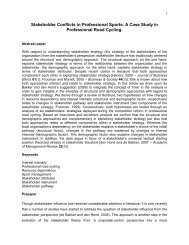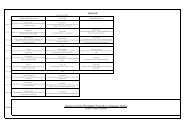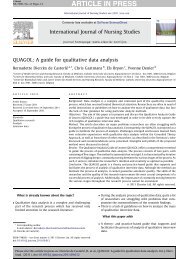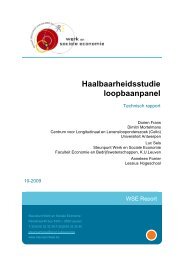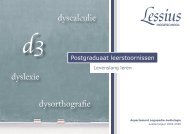The role of implicit attitudes towards food and ... - ResearchGate
The role of implicit attitudes towards food and ... - ResearchGate
The role of implicit attitudes towards food and ... - ResearchGate
You also want an ePaper? Increase the reach of your titles
YUMPU automatically turns print PDFs into web optimized ePapers that Google loves.
3.5.2. Implicit <strong>attitudes</strong> <strong>towards</strong> <strong>food</strong><br />
In a second model, ABMI change at follow up was the dependent variable, <strong>and</strong> the change in attitude <strong>towards</strong><br />
unhealthy <strong>food</strong> (RT), <strong>towards</strong> healthy <strong>food</strong> (RT), <strong>towards</strong> unhealthy <strong>food</strong> (PE), <strong>towards</strong> healthy <strong>food</strong> (PE), ABMI at the<br />
end <strong>of</strong> the treatment, age <strong>and</strong> sex were entered as independent variables. <strong>The</strong> model accounted for only 8% <strong>of</strong> the<br />
variance, <strong>and</strong> was not significant, F(7, 18)=1.22 ns (see Table 5).<br />
3.5.3. Self-reported <strong>attitudes</strong> <strong>towards</strong> physical activity<br />
In a third model, ABMI change at follow up was the dependent variable, <strong>and</strong> the change in attitude <strong>towards</strong><br />
sedentary activity, <strong>towards</strong> moderate intense PA, <strong>towards</strong> high intense PA, ABMI at the end <strong>of</strong> the treatment, age <strong>and</strong><br />
sex were entered as independent variables. <strong>The</strong> model accounted for only 3% <strong>of</strong> the variance, <strong>and</strong> was not significant, F<br />
(6, 18)=1.10 ns. (see Table 6).<br />
3.5.4. Self-reported <strong>attitudes</strong> <strong>towards</strong> <strong>food</strong><br />
In a fourth model, ABMI change at follow up was the dependent variable, <strong>and</strong> the change in attitude <strong>towards</strong><br />
unhealthy <strong>food</strong>, <strong>towards</strong> healthy <strong>food</strong>, ABMI at the end <strong>of</strong> the treatment, age <strong>and</strong> sex were entered as independent<br />
variables. <strong>The</strong> model accounted for 14% <strong>of</strong> the variance, <strong>and</strong> was not significant, F(5, 18)b1 (see Table 6).<br />
4. Discussion<br />
M. Craeynest et al. / Eating Behaviors 9 (2008) 41–51<br />
This manuscript presented a longitudinal study, investigating whether <strong>implicit</strong> <strong>and</strong> self-reported <strong>food</strong> <strong>and</strong><br />
exercise <strong>attitudes</strong> changed during a six month inpatient treatment for youth obesity <strong>and</strong> at a one year follow up.<br />
Further, it was examined whether this change explained the variance in overweight change during treatment <strong>and</strong> at<br />
follow up.<br />
A first finding was that the youngsters lost weight during the treatment, that seemed not to be regained at follow up.<br />
This lack <strong>of</strong> weight regain is in contrast with what is <strong>of</strong>ten found (e.g., Braet et al., 2003, 2004). However, the finding <strong>of</strong><br />
the present study should be interpreted with caution, as it is based on a very restricted <strong>and</strong> selective sample. As the<br />
dropout youngsters reported at baseline that they liked more unhealthy <strong>food</strong> <strong>and</strong> liked less healthy <strong>food</strong> than the<br />
remaining group, it can be assumed that especially the youngsters that regained weight after treatment, dropped out or<br />
could not be contacted at follow up. Another possibility may be that the participants further lost weight after the<br />
six months <strong>of</strong> treatment that was regained at follow up.<br />
<strong>The</strong> self-reports revealed more favourable <strong>attitudes</strong> <strong>towards</strong> healthy <strong>food</strong> <strong>and</strong> physical activity than <strong>towards</strong><br />
unhealthy <strong>food</strong> <strong>and</strong> sedentary activities. This pattern was quite stable over time. Further, a change in self-reported<br />
<strong>attitudes</strong> was not related to decrease in overweight during treatment <strong>and</strong> at follow up. Possibly, dem<strong>and</strong><br />
characteristics leading to self-presentation strategies may have played a <strong>role</strong> (see Schwarz, 1999), but this pattern<br />
can also reflect a gap between a positive attitude <strong>towards</strong> health practices <strong>and</strong> the intention to effectively perform<br />
health behaviour. Moreover, it should be noted that the <strong>attitudes</strong> were assessed when the treatment had already<br />
started.<br />
Of particular interest was the change in <strong>implicit</strong> <strong>food</strong> <strong>and</strong> physical activity <strong>attitudes</strong> during treatment, <strong>and</strong> the<br />
relation with decrease in overweight. At baseline, the participants had positive <strong>attitudes</strong> <strong>towards</strong> both healthy <strong>and</strong><br />
unhealthy<strong>food</strong>,whichwasals<strong>of</strong>oundinthetotalgroupsampleasdescribedinCraeynest et al. (2005).However,this<br />
mean effect disappeared in a longitudinal study design. Nevertheless, some specific changes in <strong>implicit</strong> attitude<br />
<strong>towards</strong> <strong>food</strong> <strong>and</strong> physical activity seemed to be related to the decrease in overweight during treatment <strong>and</strong> at follow<br />
up. More specifically, it was found that the decrease in overweight at the end <strong>of</strong> the treatment was related to<br />
becoming more positive <strong>towards</strong> healthy <strong>food</strong> during therapy. This pattern seems in line with studies that applied the<br />
Transtheoretical Model <strong>of</strong> behavioural change (Prochaska & DiClimente, 1983) on fruit <strong>and</strong> vegetable consumption,<br />
which found that increasing the perception <strong>of</strong> the benefits <strong>of</strong> the consumption <strong>of</strong> fruit <strong>and</strong> vegetables is a crucial<br />
factor for the move <strong>towards</strong> a higher behavioural stage (e.g., Cullen, Bartholomew, Parcel, & Koehly, 1998; Greene<br />
et al., 2004). <strong>The</strong>refore, it may be assumed that emphasizing the benefits <strong>of</strong> healthy<strong>food</strong>iselementaryinthe<br />
treatment <strong>of</strong> childhood obesity. Further, a more negative attitude <strong>towards</strong> high intense physical activity <strong>and</strong> <strong>towards</strong><br />
moderate intense physical activity seemed to be predictive for respectively decrease in overweight at the end <strong>of</strong> the<br />
treatment <strong>and</strong> at follow up. At first sight, these effects are not in line with the expectations. Nevertheless, they can<br />
also indicate that the youngsters who lost much weight are fed up with being intensively physical active. However,<br />
49




